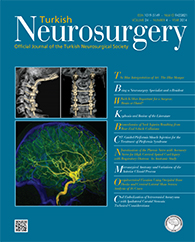2American Hospital, Department of Neurosurgery, Istanbul, Turkey DOI : 10.5137/1019-5149.JTN.8609-13.1 AIM: Previous studies have not identified a preferred surgical technique to treat posttraumatic syringomyelia. Both syringopleural shunting and arachnoidolysis are used in neurosurgery practice for the surgical treatment of posttraumatic syringomyelia. In this study, we present a new technique designed to achieve a better outcome following surgery.
MATERIAL and METHODS: A 33-year-old man, who exhibited pain and spasticity below the thoracic region after a traffic accident that occurred 16 years ago, was treated with a new technique. He also had paraparesis and urinary incontinency before the surgery. The initial cervicothoracic Magnetic Resonance Imaging (MRI) scans showed the development of a syrinx in the T4-5 region. A syringopleural shunt and bilateral subarachnoid to subarachnoid catheters from proximal to distal zones of the syrinx were performed under surgical microscope.
RESULTS: The operative time was 90 minutes, and the blood loss was approximately 100 mL. The patient was mobilized on postoperative day 2 and was discharged 4 days after surgery with mild improvement of his preoperative symptoms. Postoperative MRI scans revealed partial regression at 6 months and complete decompression of the syrinx at 3 years follow-up without any clinical symptoms.
CONCLUSION: This is a report of minimal-access insertion combining syringopleural with subarachnoid-subarachnoid bypass shunt insertion. This minimally invasive technique seems to be an effective and safe method.
Keywords : Posttraumatic syringomyelia, Shunt surgery, Magnetic resonance imaging, Subarachnoid-subarachnoid bypass, Cervical spinal cord




